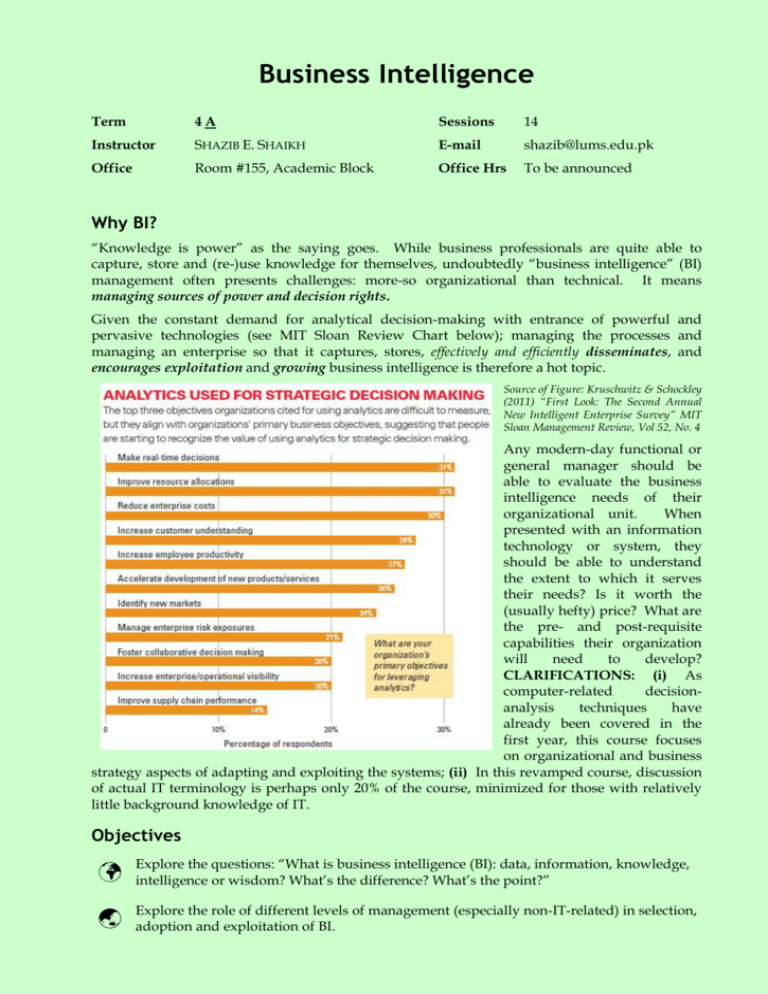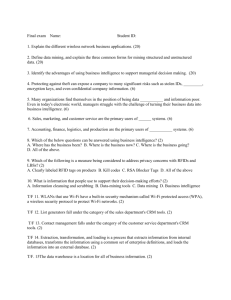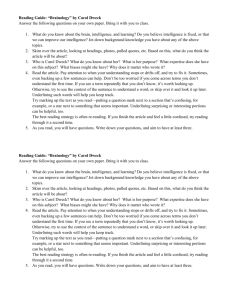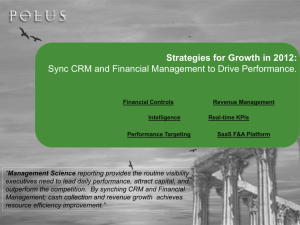Why BI? - bishaikh
advertisement

Business Intelligence Term 4A Sessions 14 Instructor SHAZIB E. SHAIKH E-mail shazib@lums.edu.pk Office Room #155, Academic Block Office Hrs To be announced Why BI? “Knowledge is power” as the saying goes. While business professionals are quite able to capture, store and (re-)use knowledge for themselves, undoubtedly “business intelligence” (BI) management often presents challenges: more-so organizational than technical. It means managing sources of power and decision rights. Given the constant demand for analytical decision-making with entrance of powerful and pervasive technologies (see MIT Sloan Review Chart below); managing the processes and managing an enterprise so that it captures, stores, effectively and efficiently disseminates, and encourages exploitation and growing business intelligence is therefore a hot topic. Source of Figure: Kruschwitz & Schockley (2011) “First Look: The Second Annual New Intelligent Enterprise Survey” MIT Sloan Management Review, Vol 52, No. 4 Any modern-day functional or general manager should be able to evaluate the business intelligence needs of their organizational unit. When presented with an information technology or system, they should be able to understand the extent to which it serves their needs? Is it worth the (usually hefty) price? What are the pre- and post-requisite capabilities their organization will need to develop? CLARIFICATIONS: (i) As computer-related decisionanalysis techniques have already been covered in the first year, this course focuses on organizational and business strategy aspects of adapting and exploiting the systems; (ii) In this revamped course, discussion of actual IT terminology is perhaps only 20% of the course, minimized for those with relatively little background knowledge of IT. Objectives Explore the questions: “What is business intelligence (BI): data, information, knowledge, intelligence or wisdom? What’s the difference? What’s the point?” Explore the role of different levels of management (especially non-IT-related) in selection, adoption and exploitation of BI. Develop the skill of creating a map of BI needs for any organizational level, function and process (without being misled by vendor’s claims of their systems). Practice valuation of benefits of information systems and technologies against BI needs (gap analysis). Become familiar with terminology of information systems that potentially deliver BI: CRM, ERP, Knowledgement Management Systems (KMS), Executive Information Systems, DSS, TPS. Exposure to BI implementation process and challenges. Grading Class Participation ......................................................................... 35% Quizzes............................................................................................ 15% Assignment/Half-course Project ................................................ 20% Final Exam ...................................................................................... 30% Teaching Plan # Case 1. Hilton Hotels: Brand Differentiation through CRM 2. KPMG Peat Marwick US: One Giant Brain e Readings The Nature of Analytical Competition (skim) 3. Canyon Ranch CRM Done Right 4. Moore Medical Corp. Mastering the Three Worlds of IT (skim) 5. Business Intelligence at SYSCO Targets: Picking Your Spots for Analytics 6. Frito-Lay: A Strategic Transition 1987-89 Note on Management Support Systems 7. Retail IT decisions at Jay-Kay’s: Leveraging the Stylo Shoes Experience The Architecture of Business Intelligence 8. Implementation of the Symbols Project at MCB When Too Much IT Knowledge is a Dangerous Thing 9. Amagansett (A) 10. BI at Canadian Tyre 11. Siemens ShareNet: Building a Knowledge Network 12. Wikis at Dresdner Kleinwort Wasserstein: (A) Why Information Technology Inspired But Cannot Deliver Knowledge Management (skim) 13. Business Intelligence at Telenor Pakistan (TBC) 14. ITC eChoupal Enterprise 2.0: The Dawn of Emergent Collaboration (skim)









